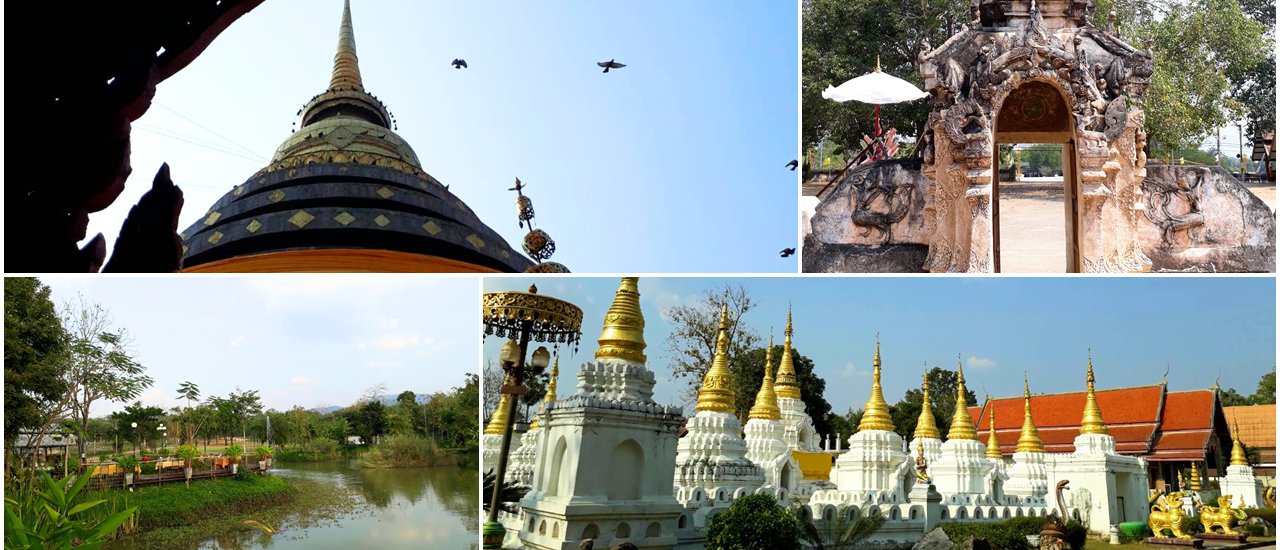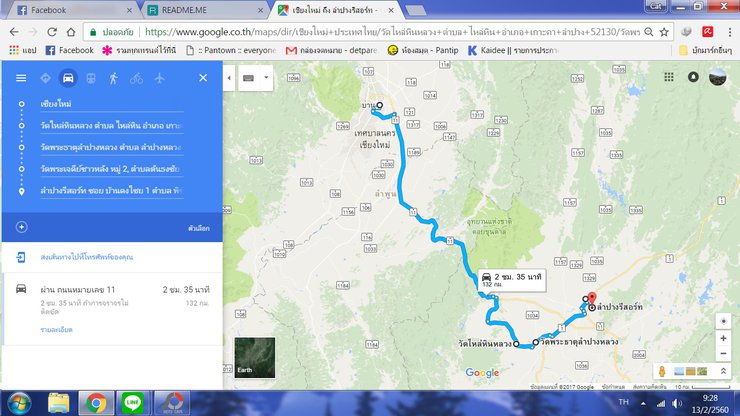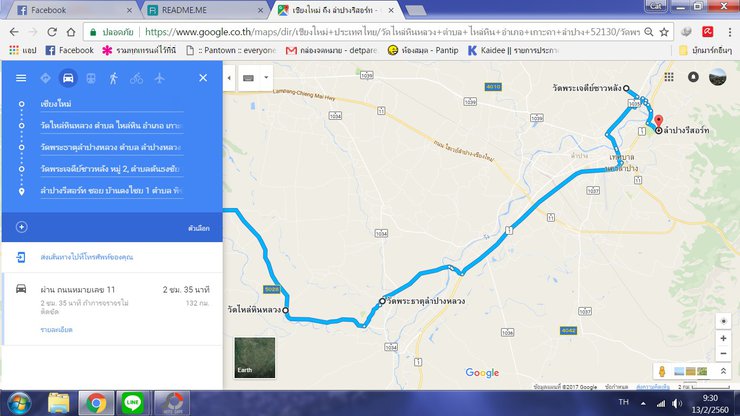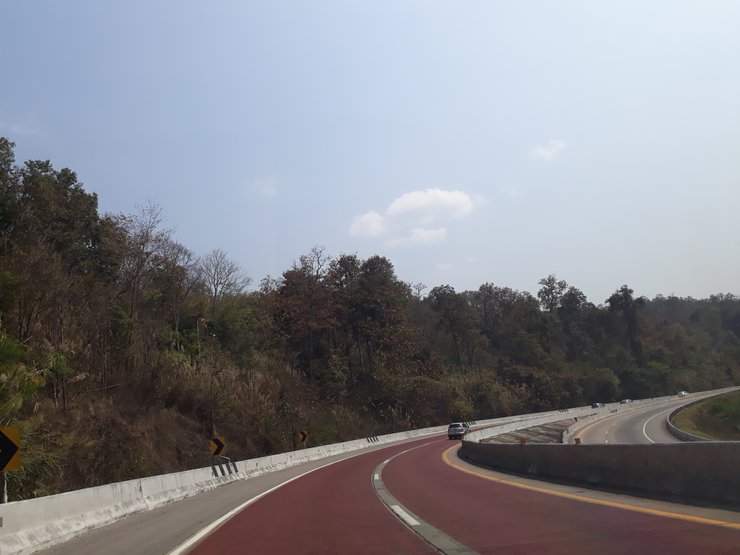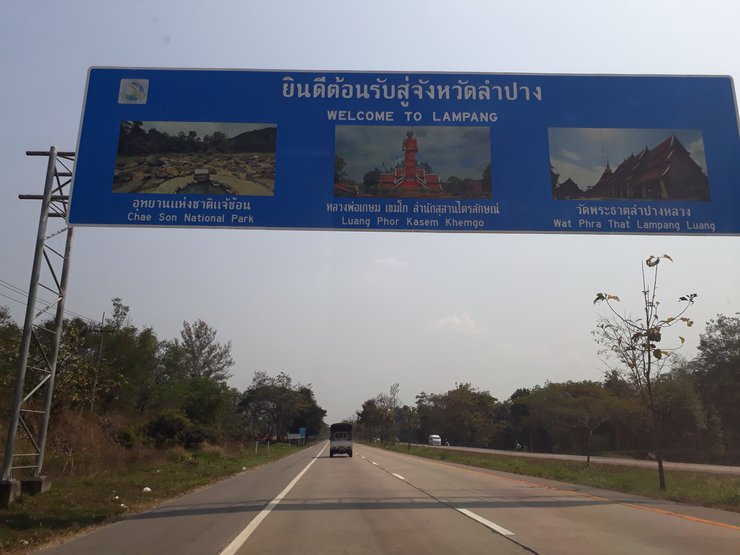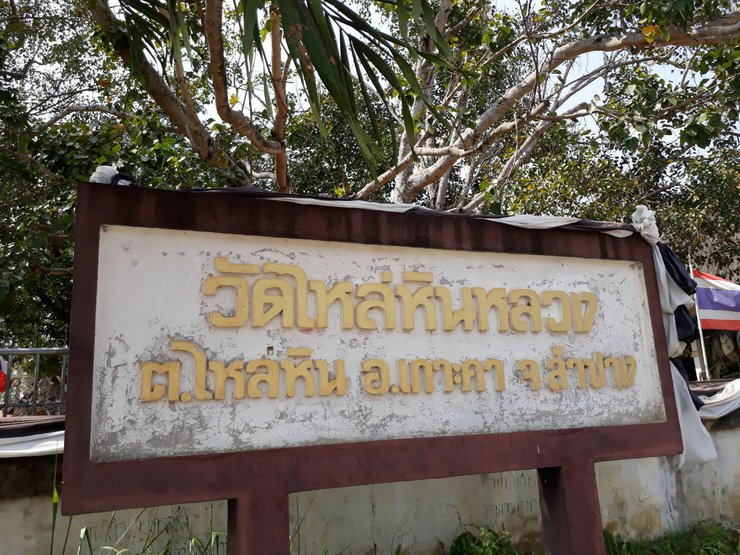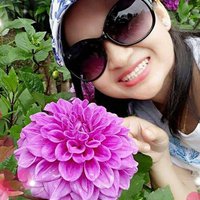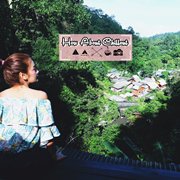**Lampang**, located in a basin surrounded by mountains, boasts a rich history. Known by various names throughout time, including **Khelang Nakhon**, Wiang Lakon, and Nakhon Lampang, it is also fondly referred to as the **"City of Horse-Drawn Carriages"**, a testament to its unique identity. This trip, undertaken in February 2017, aimed to visit the beautiful temples and monasteries of Lampang while engaging in acts of merit. The journey was made via the Chiang Mai-Lampang highway.



The leaves on both sides of the road are starting to change color, making for a beautiful and enjoyable sight.
We have arrived in Lampang City.

Visit the beauty of Wat Selaratnaratanapappatham, also known as Wat Lai Hin or Wat Lai Hin Luang Kaeo Chang Yian, located in Ko Kha District, Lampang Province. There is no definitive evidence of when it was built, but Dr. Hans Penth found the oldest palm leaf manuscript of the temple, indicating Chula Sakarat 833 or before 2514 B.E. This small, beautiful temple is nestled in nature. I had seen it in pictures and liked it, so I came to see its beauty and make merit.

The architecture of Wat Sai Hin Luang reflects the Lanna Buddhist style. It comprises a courtyard (khwang) for activities and a Bodhi tree, a viharn hall, a sala bat (monks' dining hall), a sand courtyard, and a Lanna-style stupa believed to contain relics. The layout symbolizes the Buddhist cosmology, with the viharn representing Jambudvipa, the stupa representing Mount Sumeru, and the sand courtyard representing the Mahadanta Sea.


Make merit together

The temple grounds (khwang, meaning an open, public space for various activities) are pleasantly shaded.


The **Ko Kham Gate** is a stunning architectural masterpiece, a testament to the craftsmanship of Chiang Tung artisans. Constructed in 2226 AD alongside the temple's ancient sanctuary, the gate was a collaborative effort between Kru Ba Maha Pa and the Prince of Chiang Tung. The intricate carvings adorning the gate depict various animals, including swans, birds, dragons, nagas, and mythical creatures.

Animals at the gate




The Characteristics of the Vihara
The vihara is a small, open-air structure measuring 5 meters wide and 9 meters long. It features a solid brick wall at the back. The roof structure of the vihara is designed in the "khue ma dang mai" style, a traditional Lanna wooden roof construction system that resembles stacked horse saddles supporting the weight of the purlins, rafters, and roof tiles.


The principal Buddha image in the Māravijaya attitude



Disciples

The Fine Arts Department declared Wat Lai Hin Luang as an ancient monument in 1980. The registered ancient monuments include the Lanna-style wiharn, the stupa, the ubosot, the arched gate of the surrounding wall, and the Dharma hall. In addition, in 2007, it was also listed as a heritage building by the Association of Siamese Architects.

The stupa enshrines the relics of the Buddha.





The temple also houses an exhibition hall.

The temple also has products made by villagers for sale. You can make merit with the temple by purchasing these items, which include alms bowls, woven fabrics, betel nut containers, and various flags. The prices are reasonable.



The Lanna people believe that the "tung" is a symbol of goodness and auspiciousness. It is a long piece of cloth tied to the end of a stick or pole. The offering of tung in the north is considered a sacred tradition that serves as a medium to lead the spirits of those who offer tung to heaven.

After supporting the community's products, we continued our journey to **Phra That Lampang Luang**, which is approximately 6 kilometers from Wat Phra That Lampang Luang. The scenery along the way was beautiful.

Upon arrival at the temple, you will be greeted by the iconic horse-drawn carriages of Lamphang, a unique sight that surrounds the temple grounds.

**Wat Phra That Lampang Luang**, located in Ko Kha District, Lampang Province, is the designated temple for those born in the Year of the Ox. Construction began and was completed in the Year of the Ox. The temple layout and components are exceptionally well-organized. The Buddhist sanctuary features the main Phra That Lampang Luang stupa, accessible via a naga staircase leading to the entrance arch. Beyond the arch lies the main wihan (prayer hall). To the north of the stupa are the Wihan Nam Taem and Wihan Ton Kaeo. The west side features the Wihan Lawor and the Phra Phutthabat footprint hall. The south side houses the Wihan Phra Phutthabat and the ubosot (ordination hall). These structures are enclosed by a four-sided wall. The temple grounds are beautifully landscaped and provide a serene atmosphere.



The Phra That Chedi is a Lanna-style chedi with influences from Sri Lankan architecture. Constructed of brick and mortar, it features a square base with three tiers of lotus bud moldings. The large chedi is covered with sheets of brass, intricately pierced with designs, known as "Thong Jango."

This angle captures a flock of birds in flight, creating a beautiful scene.

One of the wonders of Wat Phra That Lampang Luang that you should not miss is the "inverted shadow of the pagoda" located inside the "Phra Bat Pavilion." However, women are prohibited from entering the Phra Bat Pavilion to view the shadow.

The grand royal temple, constructed in 2019 by Chao Muen Kam Phek, boasts a large golden castle-like structure housing the revered Phra Chao Lan Thong. Behind it lies the shrine of Phra Chao Tan Jai. The ancient and exquisite murals depicting the Ten Jataka Tales and the Brahma Chakra adorn the upper panels of the wooden doorframe.

The provided text is empty. There is nothing to translate.


Bullet marks: In the past, Burma occupied Chiang Mai and Lamphun, appointing local rulers under the Burmese king's authority. Thao Mahayon, the ruler of Lamphun, led his forces to capture Lamphang and set up camp inside Wat Phra That Lampang Luang. During this time, Nan Tipthepchang, a villager from Pong Yang Khok (present-day Hang Chat district) and a hero of Lamphang, rallied the people to fight against Thao Mahayon's army. He infiltrated the temple and shot Thao Mahayon dead, causing the Lamphun army to retreat in defeat. The bullet marks are still visible on the brass fence surrounding the Phra That Chedi. Subsequently, Nan Tipthepchang was appointed as Phra Chao Tipthepchakkrasura-waritchai, the ruler of Lamphang, and became the progenitor of the Na Lamphang lineage, the Seven Clans of Chiang Mai, and the Na Lamphun lineage.
Continue to Wat Chedi Sao Lang, located in Mueang District on the Lampang-Chae Hom Road. It is one of the most beautiful temples in Lampang province, blending Lanna and Burmese art. Sao in the northern dialect means 20, and lang means towers. Therefore, Wat Chedi Sao Lang translates to "temple with 20 towers." This temple is an important religious site in Lampang province, dating back to ancient times. Evidence of this can be found in the discovery of Hariphunchai period amulets at the base of the chedi, suggesting that the temple is over a thousand years old.

The Saw Pha That Chedi, a blend of Lanna and Burmese architecture, stands beside a group of smaller chedis. Inside a nearby viharn, a bronze Buddha statue in the Samadhi posture, crafted in the Chiang Saen style, is enshrined. Locals call it "Phra Chao Tan Jai" and often visit to pray and make offerings.

A large takian tree where villagers come to seek fortune and fulfill their vows.

Children from nearby schools perform traditional music, including the salor, so, and soeng, at the temple. Donations are welcome to support the children's education.



The history of the temple.







After visiting the beautiful temples and monasteries, the evening begins to set in. Tonight, we will be dining at Lampang Resort, which offers a restaurant, accommodation, karaoke, and meeting rooms. The atmosphere is excellent, with beautiful natural surroundings and friendly staff.





While waiting for your meal, enjoy a leisurely stroll through the resort's natural surroundings.

We ordered 7-8 dishes, including ice cream, for a little over 1,000 baht. The price was reasonable, and the food was delicious.

There is a wide variety of menus to choose from, including local dishes.


The open-air bathroom is a stylish and natural touch.


Lush greenery surrounds the area, with towering trees and vibrant flowers in full bloom.

In the evenings, musicians perform beautiful songs for your enjoyment. (Closed on Sundays.)


This concludes our one-day trip. Lampang has many more beautiful temples to explore. I hope to visit again soon. Farewell! ^^

Please follow our small travel page on Facebook!
We share travel destinations we've visited.
Page: ไปแอ่วกัน Fun Trips
ไปแอ่วกัน Fun Trip
Friday, October 4, 2024 3:14 PM

